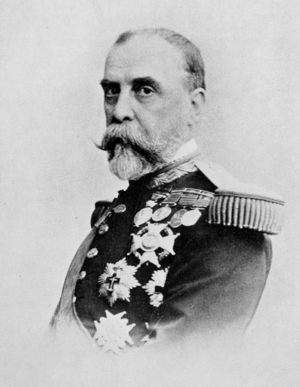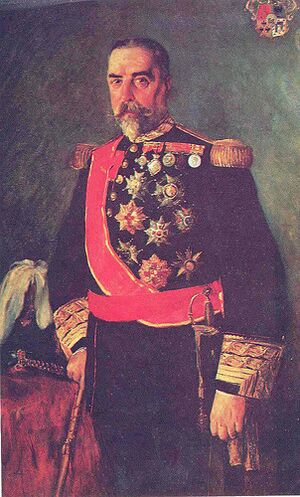Ramón Blanco, 1st Marquess of Peña Plata facts for kids
Quick facts for kids
The Most Excellent
The Marquess of Peña Plata
|
|
|---|---|
 |
|
| Personal details | |
| Born |
Ramón Blanco Erenas Riera y Polo
September 15, 1833 San Sebastián, Gipuzkoa, Spain |
| Died | April 4, 1906 (aged 72) Madrid, Community of Madrid, Spain |
| Occupation | Governor General of the Philippines (1893–1896) Captain-General of Cuba (1897–1898) |
| Military service | |
| Allegiance | |
| Branch | |
| Years of service | 1858–1906 |
| Rank | |
| Battles/wars | Third Carlist War Little War Philippine Revolution Spanish–American War |
Ramón Blanco Erenas Riera y Polo, 1st Marquess of Peña Plata (born September 15, 1833 – died April 4, 1906) was a Spanish general and a leader in Spain's colonies. He was born in San Sebastián, Spain.
In 1858, he was sent to the Caribbean. There, he helped govern Cuba and the Dominican Republic. He returned to Spain in 1861. Later, from 1866 to 1871, he served in the Philippines.
After this, he went back to Spain. He fought in the Third Carlist War and became a brigadier general. He became the captain-general of Navarre. He also received his noble title, Marquess of Peña Plata, around this time. In 1879, he was sent to Cuba again as captain-general. He was involved in the Little War there. He returned to Spain in 1881 and served as captain-general in Catalonia and Extremadura.
Leader in the Philippines (1893–1896)
In 1893, Ramón Blanco was sent to the Philippines. He stayed there until December 13, 1896. During his time, electricity came to Manila in 1893. He also spoke about a bright future for the Philippines in an exhibition in 1895.
Blanco had to deal with a movement that wanted the Philippines to be independent. This group was called Katipunan. Blanco tried to be fair and gentle. He wanted to make Spain look good to other countries. However, he still put eight provinces under special military rule. These provinces were Manila, Bulacan, Cavite, Pampanga, Tarlac, Laguna, Batangas, and Nueva Ecija. These eight provinces are now shown by the eight rays of the sun on the Philippine flag.
When the revolution started, a famous leader named José Rizal was living away from home. He had offered to work as a doctor in Cuba. Blanco allowed Rizal to go to Cuba to help people sick with yellow fever. Rizal wanted to stay out of the Philippine Revolution.
However, Rizal was arrested on his way to Cuba. Blanco could not help him because he had been removed from his job on December 13. Some powerful groups, including religious leaders, thought Blanco was too kind to the Filipinos. They complained about him to the government in Spain.
Blanco faced a big defeat in the Battle of Binakayan-Dalahican. He lost to the revolutionary leaders Santiago Alvarez and Emilio Aguinaldo. After this, Camilo Polavieja took over as Governor-General.
José Rizal was later put to death on December 30. Blanco was against this decision. Later, Blanco gave his sash and sword to Rizal's family to show his regret. Some people, like Ramiro de Maeztu, defended Blanco. They said he was wise to keep his troops safe instead of risking them in pointless battles.
Leader in Cuba (1897–1898)
Blanco was known for being fair. Because of this, the Spanish government sent him to Cuba in 1897. He replaced Valeriano Weyler, who had been very harsh. Weyler had forced many Cubans into special camps. These camps did not have enough food or medicine, and many people died there.

Blanco had to change Weyler's harsh rules for the Cubans. At the same time, he had to defend the island. This was especially true after the Spanish–American War began. In February 1898, the American ship Maine sank. Many Spanish officers, including Blanco's representatives, offered their sympathy. Blanco suggested that Spain and America work together to find out why the ship sank.
In March 1898, Blanco asked Máximo Gómez, a Cuban general, to join him. He wanted Gómez and his Cuban soldiers to fight alongside the Spanish army against the United States. Blanco reminded them that Cubans and Spaniards shared a history. He promised Cuba would become independent if they helped fight the Americans.
Blanco said: "As Spaniards and Cubans, we are against foreigners who want to take our land. Now is the time to forget our past problems. Spaniards and Cubans should unite to defend ourselves. Spain will remember the help of its Cuban children. Once the enemy is gone, Spain will welcome Cuba as a new daughter nation." However, Gómez refused Blanco's offer.
Blanco believed it was better to fight than to give up to the Americans. He ordered Pascual Cervera y Topete to try and break the American blockade. This led to the Battle of Santiago de Cuba.
During Blanco's time as governor, the remains of Christopher Columbus were moved. They were taken back to the Cathedral of Seville in Spain. Blanco returned to Spain after the Spanish-American War ended.
Honours
- Grand Cross of the Military Merit Order, 1874 (Spain)
- Grand Cross of the Order of the Red Eagle, January 4, 1886 (Kingdom of Prussia)
See also
 In Spanish: Ramón Blanco y Erenas para niños
In Spanish: Ramón Blanco y Erenas para niños

